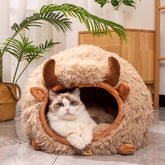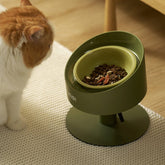Preparing Your Home for Your New Cat: A guide for cat owners who are getting ready to welcome a furry friend

If you are planning to adopt a new cat, congratulations! You are about to embark on a wonderful journey of companionship and love. However, before you bring your new furry friend home, you need to prepare your home and make it comfortable and welcoming for your new pet. In this article, we will give you some tips on how to do that, such as cat-proofing your home, providing the essentials, and introducing your cat to its new environment.
Ensuring Your Home is Safe from Cats
Before you bring your new cat home, you need to make sure that your home is safe and cat-friendly. Cats are curious and playful animals, and they can get into trouble if they encounter hazards or temptations. Here are some tips to cat-proof your home and make it safe for your new pet:
-
Keep all wires, cords, and cables out of reach or secured with cable ties or covers. Cats can chew on them and get electrocuted or injured.
-
Store all medicines, chemicals, cleaning products, and other toxic substances in locked cabinets or high shelves. Cats can ingest them and get poisoned or sick.
-
Remove or secure any breakable or sharp objects that can fall or hurt your cat. Cats can knock them over or cut themselves on them.
-
Check all windows, doors, and screens for gaps or holes that can allow your cat to escape or get stuck. Cats can be very agile and adventurous, and they may try to explore the outdoors or hide in small spaces.
-
Provide scratching posts or pads for your cat to scratch and groom their claws. Cats need to scratch to keep their claws healthy and to mark their territory. If you don't provide them with appropriate scratching surfaces, they may scratch your furniture, carpets, or walls.

Laying the groundwork for comfort: a litter box, nourishment, and hydration station
Another important step to prepare your home for a new cat is to set up their litter box, food and water station, and other essentials. Cats are very clean and sensitive animals, and they need a comfortable and hygienic environment to feel happy and relaxed. Here are some tips to set up your cat's litter box, food and water station, and other essentials:
-
Choose a quiet and private location for your cat's litter box, away from their food and water station and from high-traffic areas. Cats prefer to do their business in peace and privacy, and they don't like to eat or drink near their litter box.
-
Choose a litter box that is large enough for your cat to turn around and dig comfortably, and that has low sides for easy access. You can also use a covered litter box for extra privacy, but make sure that your cat likes it and can enter and exit easily.
-
Choose a litter type that is unscented, clumping, and dust-free. Cats are very sensitive to smells and textures, and they may avoid using a litter box that has a strong odor, is too hard or soft, or produces too much dust.
-
Clean your cat's litter box daily, and change the litter completely every week. Cats are very clean and will not use a dirty litter box. A dirty litter box can also cause health problems and odors in your home.
-
Provide your cat with fresh, clean water at all times, and change it daily. Cats need to stay hydrated and drink plenty of water, especially if they eat dry food. You can also use a water fountain or a dripping faucet to encourage your cat to drink more.
-
Provide your cat with high-quality, balanced, and age-appropriate food, and follow the feeding instructions on the label. Cats need a diet that is rich in protein, fat, and essential nutrients, and that suits their life stage and health condition. You can also consult your vet for the best food for your cat.
-
Feed your cat in a clean and quiet area, away from their litter box and from other pets or kids. Cats like to eat in peace and without distractions or competition. You can also use puzzle feeders or interactive toys to make feeding more fun and stimulating for your cat.
Creating a secure and welcoming environment for the transition
When you bring your new cat home, you need to provide them with a safe and comfortable space for the transition. Cats are very territorial and sensitive to changes, and they need time and patience to adjust to their new home and family. Here are some tips to provide your cat with a safe and comfortable space for the transition:
-
Set up a small and cozy room for your cat, complete with a litter box, food and water station, bed, toys, and scratching post. This area will serve as your cat's safe space, allowing them to feel secure and explore at their own pace. If you don't have an extra room, a quiet corner with a fully enclosed space, such as a cat bed, would be a great alternative.
-
Let your cat stay in their safe space for the first few days, and visit them regularly to interact and bond with them. Don't force your cat to come out or to meet other pets or people. Let your cat decide when they are ready to venture out and socialize.
-
When your cat shows signs of curiosity and confidence, you can gradually introduce them to the rest of the house and the family. Use treats, toys, and praise to reward your cat for being brave and friendly. Don't rush or overwhelm your cat with too many new sights, sounds, and smells.
-
Monitor your cat's behavior and health during the transition, and look for any signs of stress, anxiety, or illness. Some common signs are hiding, hissing, scratching, spraying, not eating, not using the litter box, or grooming excessively. If you notice any of these signs, consult your vet or a cat behaviorist for advice.

Simple toys to keep cat engaged
One of the best ways to make your home more fun and stimulating for your new cat is to provide them with simple toys to keep them engaged. Cats are natural hunters and players, and they need physical and mental exercise to stay healthy and happy. Here are some simple toys to keep your cat engaged:
-
Feather toys, wand toys, or fishing pole toys. These are toys that have a feather, a string, or a toy attached to a stick or a pole, and that you can move around to mimic a prey. These toys are great for stimulating your cat's hunting instincts and for playing with them interactively.
-
Balls, mice, or crinkle toys. These are toys that are small, light, and easy to roll, toss, or chase. These toys are great for encouraging your cat's natural curiosity and for playing with them independently.
-
Paper bags, cardboard boxes, or tunnels. These are toys that are simple, cheap, and easy to find, and that provide your cat with hiding and exploring opportunities. These toys are great for satisfying your cat's territorial and adventurous needs and for playing with them creatively.
-
Catnip toys, silvervine toys, or valerian toys. These are toys that are infused with natural herbs that can stimulate your cat's senses and make them more playful and relaxed. These toys are great for enhancing your cat's mood and for playing with them occasionally.

Pets and Kids at Home: Things to Note
If you have other pets or kids at home, you need to take some extra steps to prepare your home for a new cat and to make the introduction process smooth and positive. Cats can get along with other animals and children, but they need time and guidance to establish a harmonious relationship. Here are some things to note if there are pets or kids at home:
-
Keep your new cat separated from your other pets for the first few days, and let them get used to each other's smells and sounds through a closed door. Then, introduce them gradually and under supervision, using treats, toys, and praise to create positive associations. Don't force them to interact or to share resources. Let them set their own pace and boundaries.
-
Teach your kids how to interact with your new cat respectfully and gently, and never leave them alone with your cat. Show your kids how to pet, hold, and play with your cat, and how to read your cat's body language and signals. Don't let your kids disturb your cat when they are eating, sleeping, or using the litter box. Don't let your kids tease, chase, or hurt your cat.
-
Provide your cat with plenty of places to escape and relax, such as high shelves, cat trees, or cozy beds. Cats need to have their own space and privacy, especially when they share their home with other pets or kids. Give your cat the option to retreat and rest whenever they feel overwhelmed or stressed.
Adopting a new cat is a rewarding and exciting experience, but it also requires some patience and preparation. You need to make sure your cat feels comfortable and safe in their new environment, and that they get along well with your other pets and kids. By following these tips, you can help your cat adjust to their new home and family, and enjoy a happy and healthy life together.























